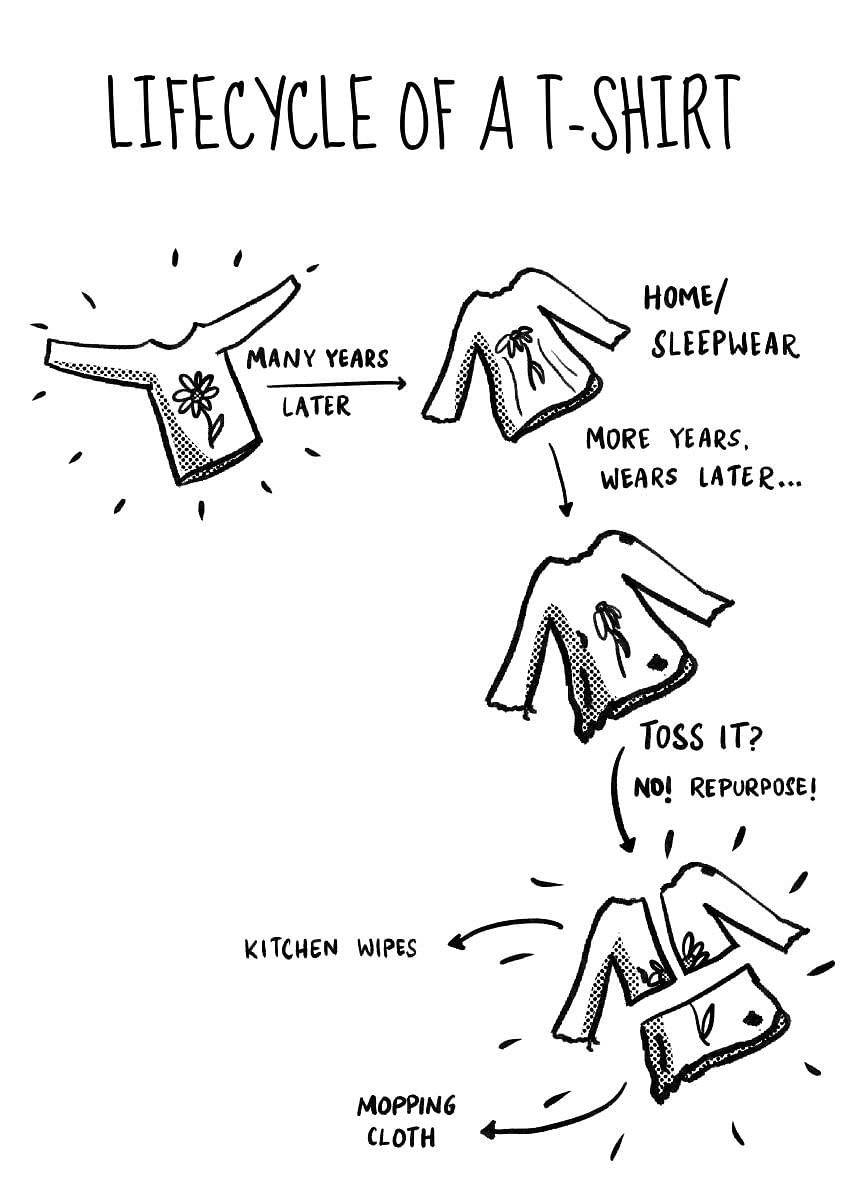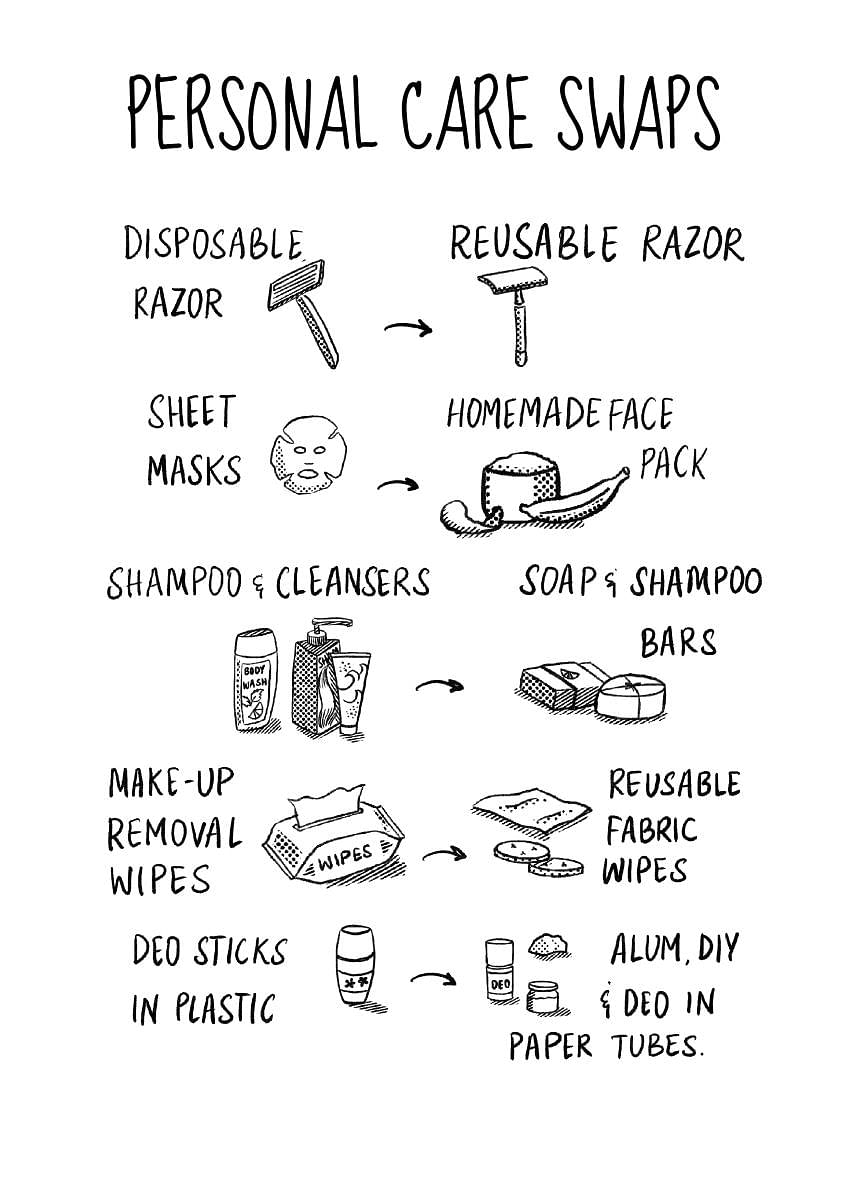

It’s no secret that the world today looks very different from what it used to be 30 years ago. For starters, the term ‘zero-waste’ was not a buzzword yet. There was no Instagram that threw up 8.8 million instances if you searched for #zerowaste. Of course, the amount of waste that the world was generating back then was a fraction of what it is now as well. Some of the more common results for the hashtag are photos of kitchens with pantry supplies in beautiful uniform glass containers, and photos of people at bulk supply stores where you can take your own containers to buy your kitchen staples, thus avoiding the packaging waste.
But while buying things free of plastic packaging, or in recyclable or reusable packaging is great, packaging waste forms only one part of the waste we generate. We need to consider managing the end-life of a product — whether it gets composted or recycled or dumped into a landfill. This is called downstream waste, which we will talk about a little later. But again, that is not all. We quite often tend to forget that there is waste produced in the manufacturing process of the things we consume. This is referred to as upstream waste. Maybe it isn’t quite as ‘grammable’ as the typical zero-waste aesthetics of brown paper, glass, wood and unbleached cotton — but it would be a mistake to lose sight of it.
Upstream waste is real
The shirt that you’re wearing did not just come in the box or plastic wrapper that it came in. Assuming it’s made of natural fibres, someone cultivated crops, tended to and harvested them. It was then turned into yarn, dyed and then woven into fabric. After the fabric was ready, it was tailored into a shirt and shipped to a warehouse before it reached you.
At every step of the process, there was waste generated — agricultural waste, effluent waste, tailoring waste — and not to mention, the fuel used and the footprint of transporting to reach you. (The textile industry is one of the most water-intensive ones.) This is upstream waste. When we buy a shirt and think of how to take care of the disposal of the packaging and the shirt itself once we’re done with it, we are only thinking of downstream waste. All our attempts at recycling or responsibly disposing of the downstream waste still won’t offset or make the upstream waste disappear.
This is applicable to everything we consume — personal care products, shoes, gadgets, household goods, and the food we eat and many more things as well! It is an irrefutable fact that there is upstream and downstream waste created for everything we use and consume, and that they both need to be managed as responsibly as we can.
Instead of managing the waste, the easiest solution is to try and not create it in the first place. Especially with upstream waste not being wholly in our control, it is the simplest thing we can do. And how do we do that?
By simply reducing the number of things we buy. It’s fairly obvious if you think about it. By buying what we only absolutely need, and by looking for secondhand options wherever possible, we are reducing the demand for new products.
Of course, this isn’t always an option with all the things we might need, but it’s worth exploring when it is. Can you imagine how much the load on our planet will lessen if, on a larger scale, we all move towards buying lesser and buying used when we can? The good news is that there are many options available now to buy, sell, or even swap used goods, especially clothing. ThisForThatCloset, ReLoveCloset and TheExchangeRoom are some of the options.
Buying lesser and buying secondhand are things that we as consumers can do to reduce waste. Besides these, bigger changes at a systemic level will enable quicker, and large-scale impact. This is where the concept of a circular economy comes in.
Can circular economy be the norm?
Everything in nature is cyclical. The night follows the day, and the day follows the night and the cycle repeats. Plants are food for animals, and animal excreta in turn become food for plants. The seasons change like clockwork every few months and the cycle goes on. What if our systems were designed that way? Instead of a linear pattern, what if our systems were designed to run in a cycle, or a closed-loop?
Currently most systems are designed to be linear — we take resources, make products and then discard them. A fresh batch of raw material is then used to make every new batch of products in linear systems. In a circular system, the idea is to discard nothing, or reuse as much as possible. So the components from an old machine would be either refurbished or recycled and go into a new machine, instead of mining for fresh raw material and starting from scratch. This is the core of the concept of circular economy.
The Ellen MacArthur Foundation defines a circular economy as driven by design, and based on three principles: designing waste out of the system, circulating materials to keep them in the system for as long as possible so they don’t end up in landfills, and returning organic matter to the soil.
For example, when we buy a fridge, what if it was treated as if the company that sells us the fridge is leasing out a refrigeration service, instead of selling us a product? So when the fridge reaches the end of its life, the company sends us a replacement, and the fixable parts in the old fridge are used as parts for a new fridge, while the unfixable components are sent for recycling.
Wouldn’t it be great if all companies cared for the environment as much as they cared for profits? What if they pooled in resources and shared their know-how to find the most optimal and sustainable solutions? Wouldn’t it be great if circular systems become the norm and not the exception?
What you can do in the meanwhile
Yes, circular systems becoming mainstream will take time. What can we do to minimise the waste that will continue to mount? We can get into the habit of doing some simple things that can go a long way in making an impact on our planet. The emphasis is on getting into the habit, because ultimately, living sustainably has to be something that we can sustain. Buying less, and buying used wherever possible are a couple of broad ideas. Here are twelve tips to keep in mind:
Before you buy something, pause and ask yourself if you really need it — or if you’re buying it because it’s on sale. And also, take a moment to think about where this comes from and what the end of its life will look like. These questions will give you pause and help reduce impulse buys.
Besides your phone, wallet and keys, add a water bottle, bag, handkerchief and a snack to your list of things to take when you step out. This will drastically cut down on the single-use waste you generate.
When in doubt, ask your parents and grandparents what they used to do — the solutions are often simple and right in front of us.
Start segregating your waste — besides dry and wet waste, try and segregate paper, hard plastics, soft plastics and cartons. This will give you a sense of how much waste you generate.
Wash all your takeaway containers before throwing them away. If possible, find a waste management service near you who can take them and ensure that they get recycled.
Avoid single-use products, regardless of whether they are made of plastic, paper or even ‘biodegradable’ materials. Opt for things that you can buy once and use over and over again.
When you order in — say no to those tiny packets of ketchup, pizza seasoning etc. Also, instead of ordering in, consider carrying your own containers to take away the food whenever you can.
While at hotels, avoid single-use toiletries and carry your own.
Avoid impulse-buying clothes from ‘fast fashion’ brands — those that have cheap, trendy clothing and launch new styles every other week. If the price is too good to be true, it is likely that someone else is paying a price for it — most likely the people making it, and our planet.
If you’re having a party at home, or an event, instead of disposable plates and cutlery, consider asking your guests to bring their own reusable tableware; if not, consider getting them from cutlery banks that rent them out.
The real What-Ifs
* What if you didn’t need to buy clothing for your children; and instead, you could rent and return them for bigger sizes as they grow older?
* What if you do not buy those heavy jackets and gloves before going on that Uttarakhand trek, but simply rent them instead? (If you have the option of borrowing, please do!)
* What if all agricultural waste could be repurposed to serve multiple industries? For example, India throws away 24 million tonnes of rice husk every year — what if all of that could be put to good use, say in construction to make bricks, or for packaging or insulation?
* What if we went back to growing our food and living in harmony with nature, and cultivated and harvested smaller batches of seasonal crops, without stripping the soil of all nutrients thanks to over-farming?
* What if your favourite food delivery service also took back empty food containers and, depending on the material, ensured that they are recycled or composted? What if they incentivised it? Wouldn’t that increase the chances of people washing and returning the containers?
* What if all systems were designed with the planet in mind?
(Excerpted with permission from (Im)Perfectly Zero Waste)
Srini Swaminathan is a Chennai-based social development consultant. Over the last seven years, he has been adopting small but impactful measures in his daily life on the path to sustainable living in urban India. Shubhashree is a Bengaluru-based visual artist and illustrator. As part of the Let’s Talk Trash project, she has produced illustrated books to get the conversation started about our waste footprint. The duo have recently co-authored two books, (Im)perfectly Zero Waste and The Everyday Eco-Warrior published by Hachette India.